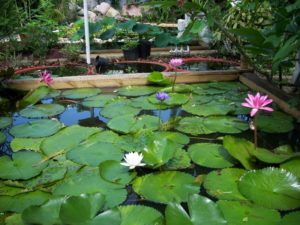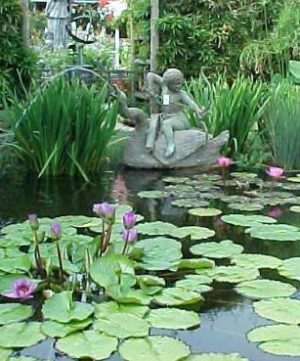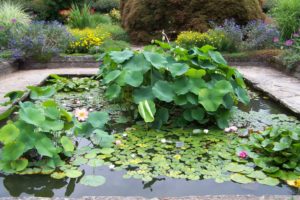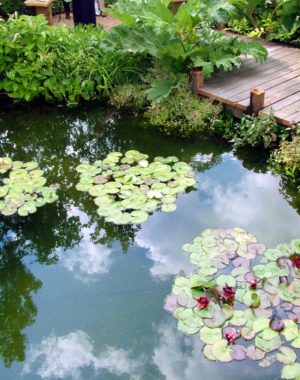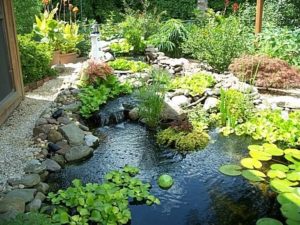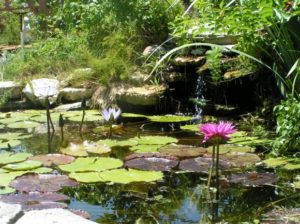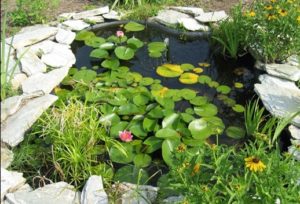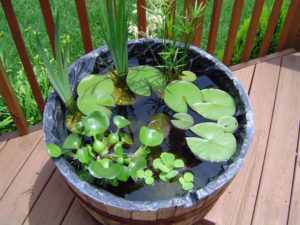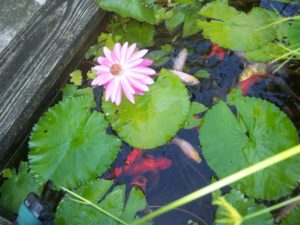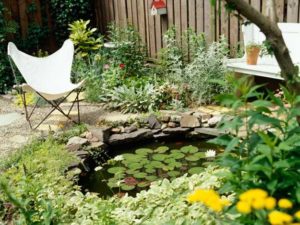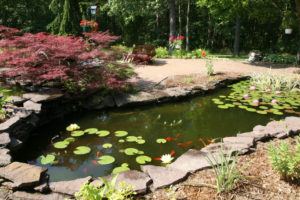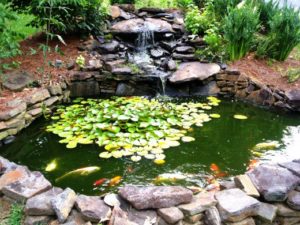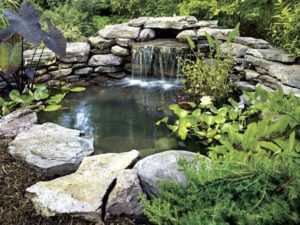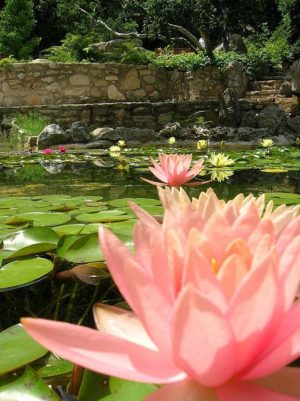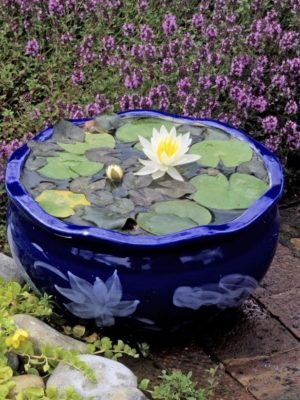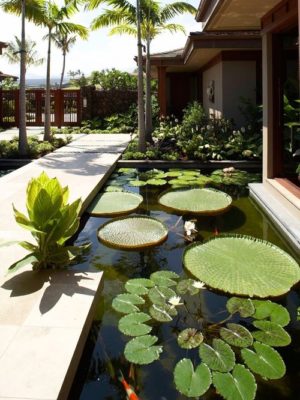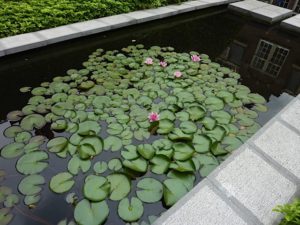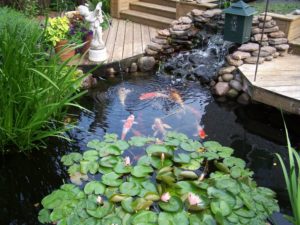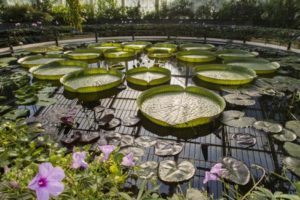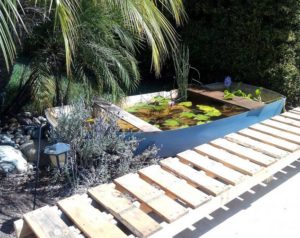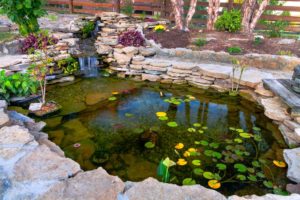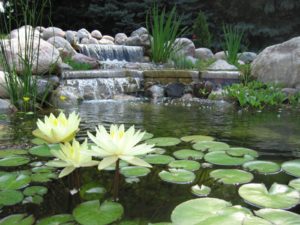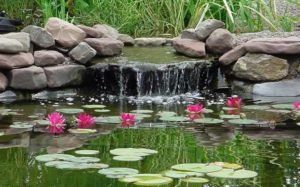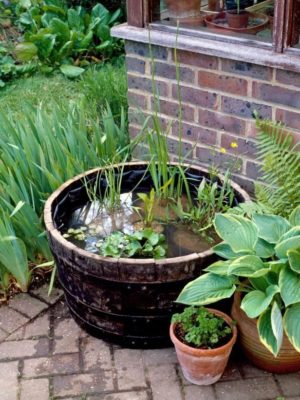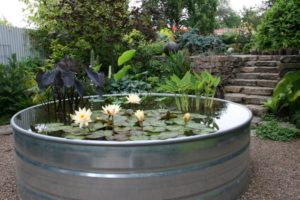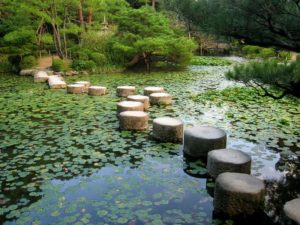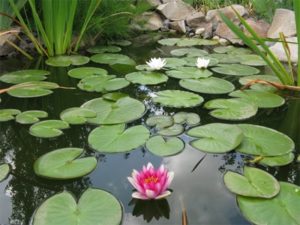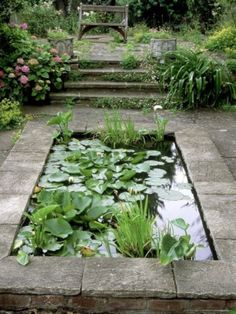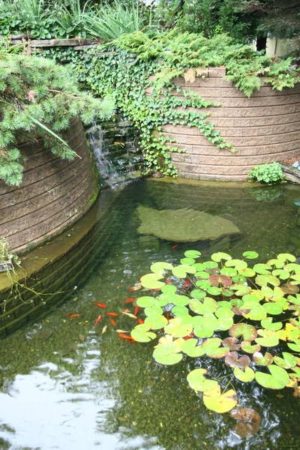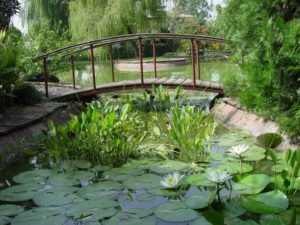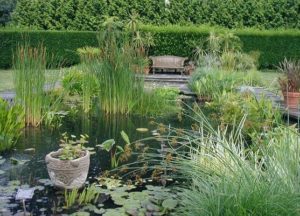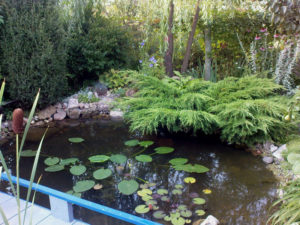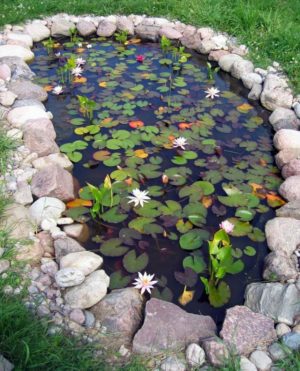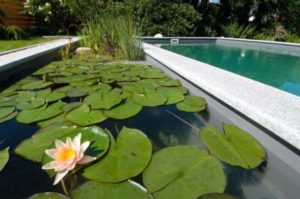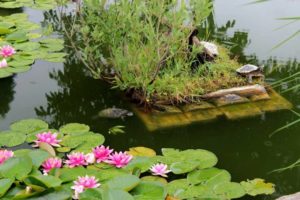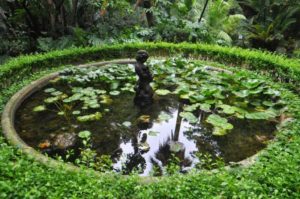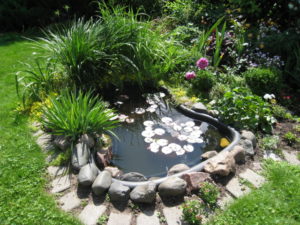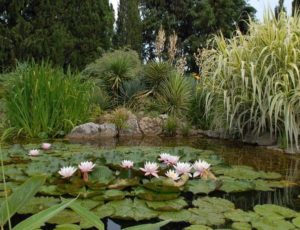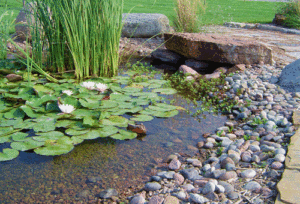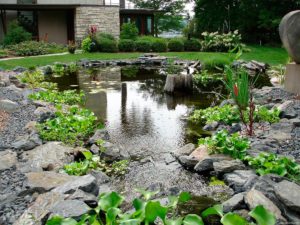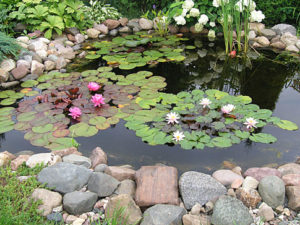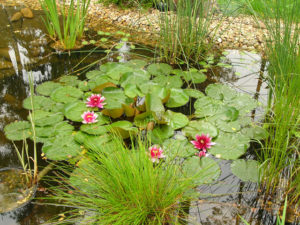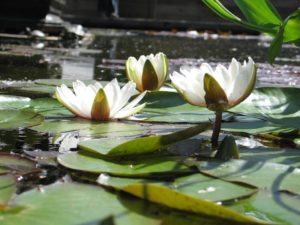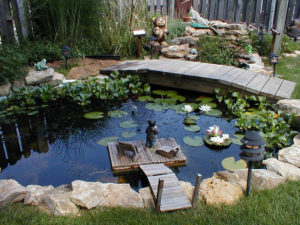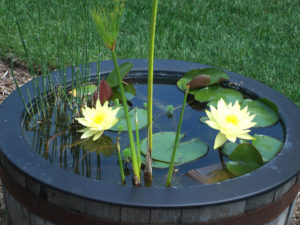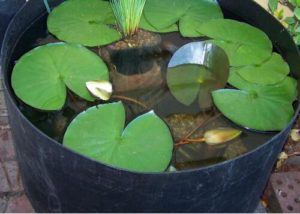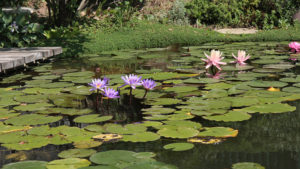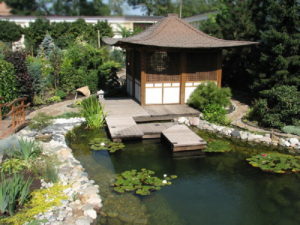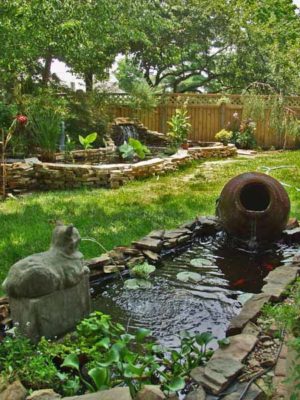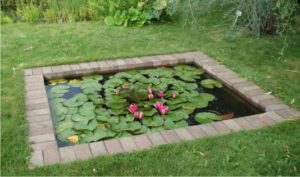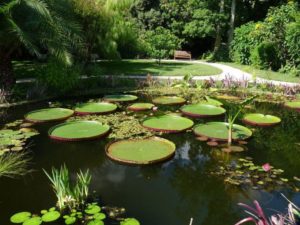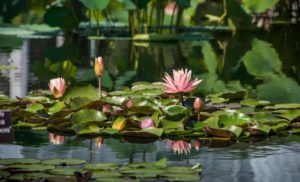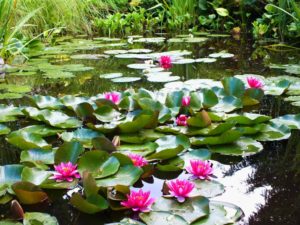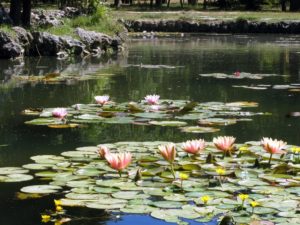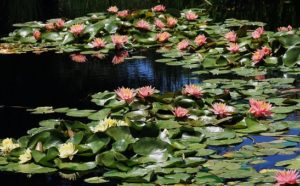Water lily, nymphea, water lily - the queen of quiet backwaters has many names. She is always a welcome guest of summer cottage landscapes, only some of them start a nymphaeum to revive the pond, while others equip ponds to settle this unearthly beauty in it.
The maintenance of plants is not particularly problematic, so it is not difficult to make friends with them, but still there are several nuances that admirers of the nymphaeum flower would do well to know about.
Why nymphaeum?
The Latin name for the water lily was given by its association with a water nymph. The Slavs knew the snow-white water lily as an overpowered grass or a mermaid flower. There was a belief that the nymph bud was able to protect travelers and bring them success in the enterprise. The flower was put into an amulet and worn with oneself.
Water lily for the pond: species diversity
The size
In the case of breeding water lilies, this parameter becomes the leading one. Today, plant breeders have bred hundreds of variations. The main classification comes down to belonging to the size range:
- dwarf;
- small;
- medium;
- large.
Flower care and breeding opportunities may be similar, but planting will have a guaranteed individual way.
Dwarf nymphs 30 - 60 cm in circumference and a flower diameter of 5 - 10 cm, planted under water no deeper than 10 - 15 cm.
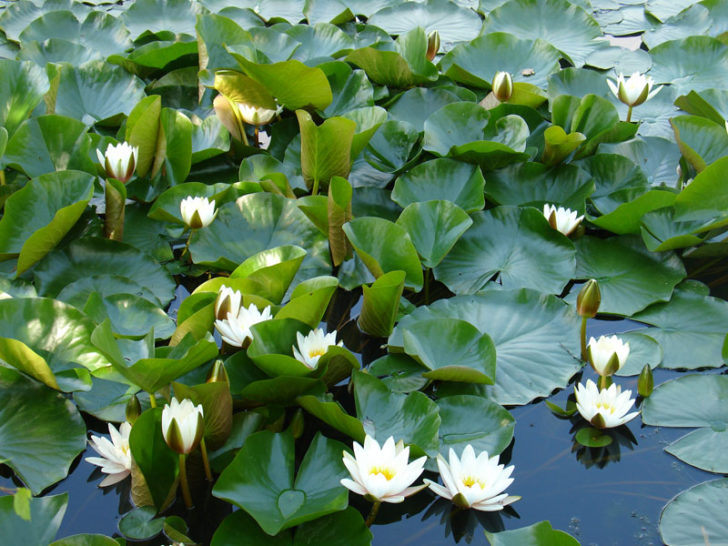
pygmy nymphaeum
small water lilies, characterized by 10 - 15 cm flower bowls and a total spreading of 60 to 120 cm, deepen by 15 - 50 cm.
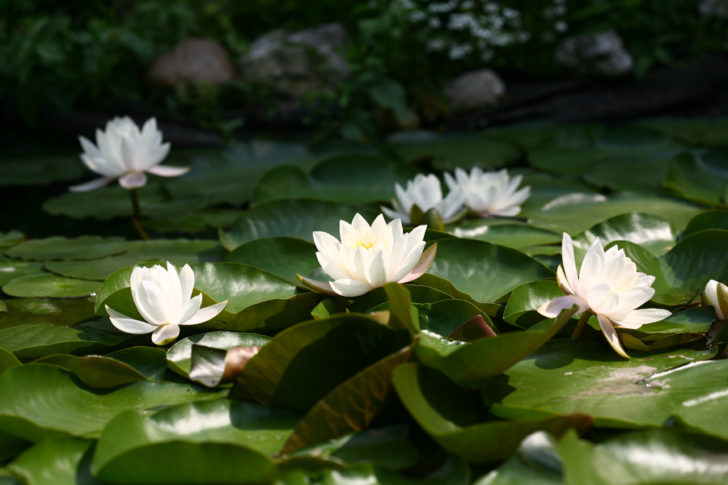
small water lilies
Medium plants, such as a snow-white water lily, occupy from one hundred and twenty centimeters to one and a half meters of the water surface and bloom with 15-18 centimeter flowers. They need a depth of 40-60 cm.
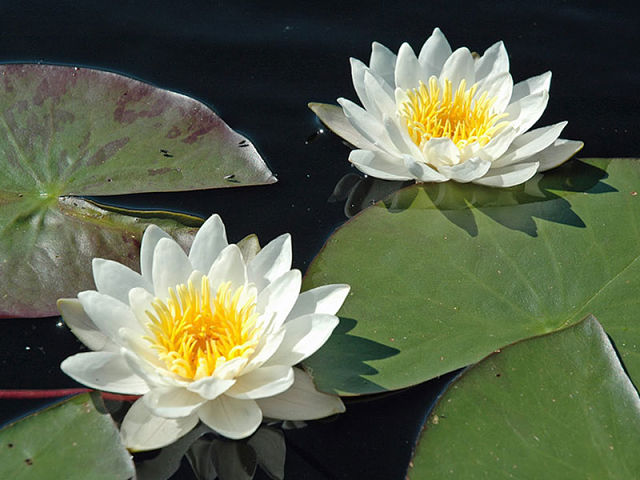
Medium-sized water lilies
The largest water lilies, with luxurious flowers up to 25 centimeters in diameter, are scattered on the water surface by 1.5 or even 2.5 meters. Their habitat is water bodies with a depth of at least half a meter. Landing them will be complicated by deep work, but the result will exceed expectations.
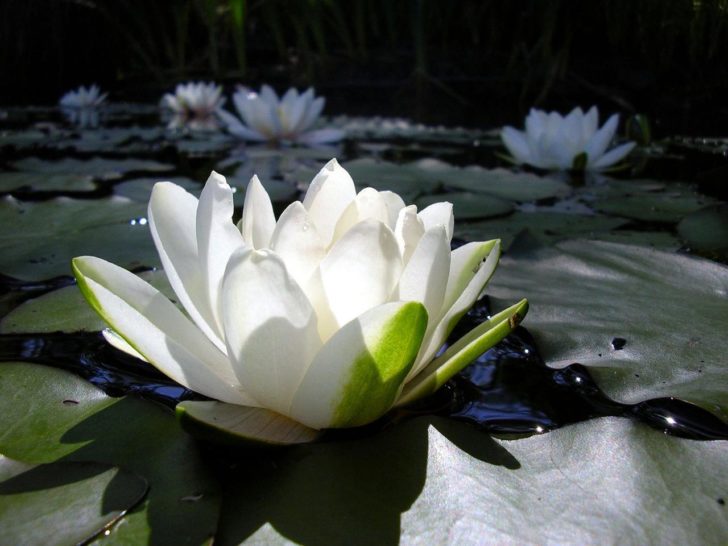
Large water lilies
Knowing this classification, you can easily choose an assortment of ornamental plants for a country pond. If this is not yet available, then first you need to figure out what type of water lilies you would like to grow, and already focusing on this, prepare a pit.
Remember, it will be possible to plant everything that your heart desires only in a large reservoir. Miniature varieties will also feel wonderful:
- in a shallow pond
- tubs,
- barrel.
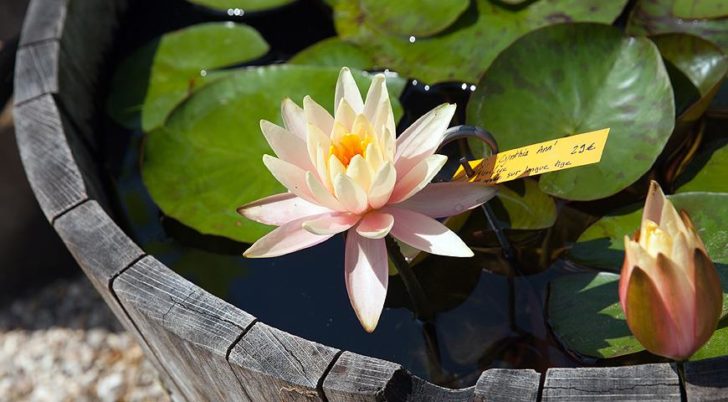
Small water lilies can be planted in a barrel
Nuances of choice
For the correct selection of varieties, you should focus on the planting depth indicator. How it's done? For example, your pond has an average depth of 50 cm. The height of the planting container is 20 cm. Subtract twenty from fifty and get the figure 30 cm. Representatives of dwarf and small water lilies correspond to this planting depth. From their representatives, you should choose the vegetation for this reservoir.
Another indicator that should not be overlooked is the spreading of the plant. Floating foliage should not cover more than a third of the water surface. A pond completely overgrown with water lilies will look more like an earthen flower bed than an unusual landscape object. If you plan to plant in one pond not only a snow-white water lily, but also several more varietal varieties of nymphs, then delimit the plantings with strips of free water. So your pond will look more impressive.
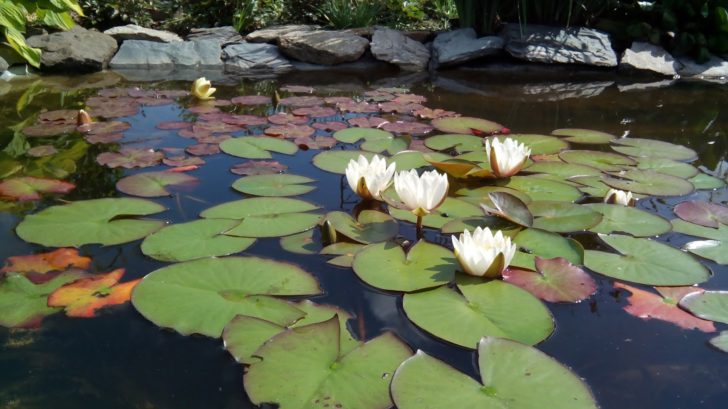
Water lilies should not cover more than a third of the pond
Popular varieties
“If you are already breeding nymphs in your pond, then pink, yellow or generally black”
Pure white water lilies for the pond have long ceased to seem unusual to our summer residents, so they eagerly look for outlandish varieties to their delight and surprise to their neighbors. If we are already breeding nymphs in our pond, then pink, yellow or generally black. White individuals may be present to enhance contrast. Blue and blue water lilies in our latitudes, unfortunately, do not survive, but even without these masterpieces it is quite possible to adequately decorate a garden pond.
The most popular and unpretentious in care are the following types:
1. White-flowering: Albatross with a planting depth of 30 - 60 cm, medium-sized Virginia Gonner and White Sensation.
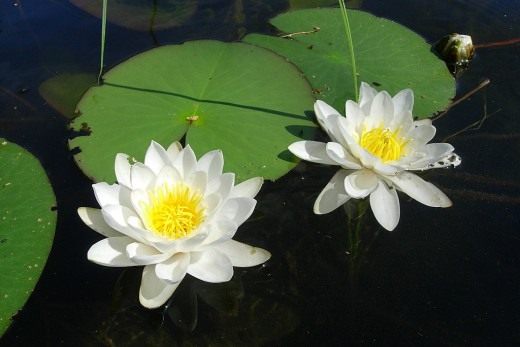
Water lily Albatross
2. Among pink-flowering, for half a meter and less depth of reservoirs, Fire Crest and Fabiola water lilies are most often ordered, from the larger varieties James Brydon and representatives of Perris Fire Opal are chosen.
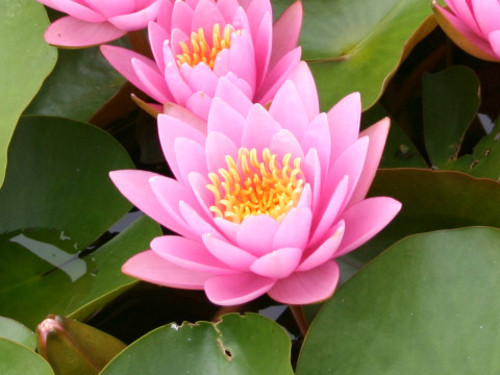
Water lily Fabiola
3. Red-blooming: Pygmy Rubra is a great choice for shallow waters. Their planting depth is from 20 cm. For deeper objects, it is better to choose Red Queen, Perris Baby Red or Red Beauty.

Red-blooming water lily Pygmy Rubra
4. Yellow and orange water lilies of Halvol and Aurora are also suitable for mini-ponds. Yellow Queen, Florida Sunset, Gold Medal and Peach and Cream planted at medium depth look wonderful.
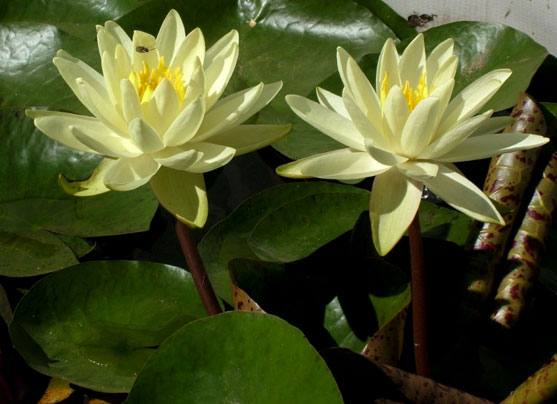
Water lilies Gold Medal
5. Conditionally black. They are the most decorative in compositions. The dark red and dark beet petals of Elmost Black and Black Princess are beautifully set off against the background of a snow-white water lily.

Water lilies varieties Elmost Black
Although white water lilies have faded into the background, nevertheless, they should not be completely discounted. They are far from outsiders, and for our latitudes, where the wintering of plants is severe, they can generally be considered a real find, so they are worth taking a closer look at.
Water lily snow-white frost-resistant
An adult plant spreads over a pond, occupying up to 1.2 m. This type of water lily is universal. It is suitable for both huge expanses of water and tiny ponds. Its stem can stretch up to 4 meters.
The flower of this nymphaeum is small, only 10 cm, but has a variety of colors: from snow-white to pale cream, and is very decorative. He seems to live his own life, watching which is a real pleasure. The bud opens at dawn and hides at sunset. The water lily pleases with its flowering from the beginning of summer until the last days of September. The aroma of flowers is similar to the smell of roses.
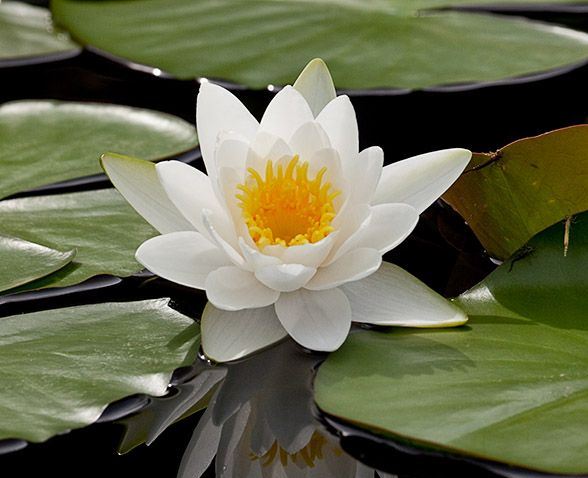
Snow-white frost-resistant water lily - the most versatile type
White water lilies look great surrounded by red relatives. Delicate landscapes are obtained by combining them with pink and yellow nymphs.
The main advantage of the plant lies not only in its decorative effect, but also in its excellent frost resistance. This variety of water lilies for ponds tolerate fifty degrees of frost without much care.
back to index ↑Growing water lilies
Landing
There are two ways to plant a pond with nymphs:
1. Using containers.
2. Directly into the soil of the bottom of the reservoir.
In the first case, for growing water lilies, you will have to purchase stable mesh baskets.The container planting method is more preferable, since the root system located in a limited space will not be able to grow uncontrollably. It will be easier to solve the issue of wintering water lilies.

Container way of planting water lilies
Planting nymphs in fairly spacious containers will allow them to grow and develop freely for several years. The volume of the container cannot be less than 5 liters. For large varieties of water lilies, baskets from a ten-liter volume should be used.
To prepare the container for planting, its walls are lined with linen burlap, after which they are filled with earth so that about 8 cm remain to the top edge. Water lily roots are placed on the soil and covered with a substrate that will need to be tamped. In order to prevent the top layer of the soil substrate from floating up and eroding, it is well covered with pebbles.
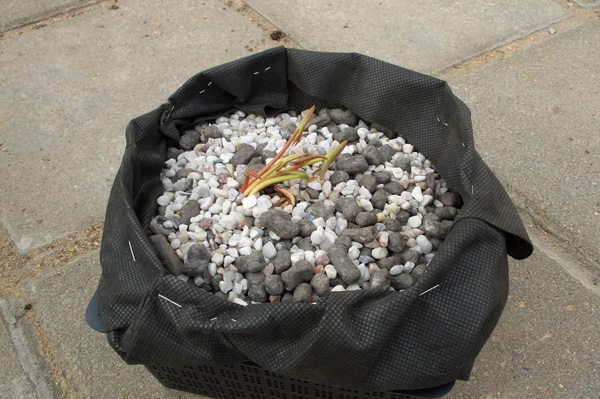
Pebbles will not allow the container to float
If there are no pebbles at hand, you can make an insulating layer of clay and close it with the hanging ends of the burlap. The last procedure will be abundant watering. After it, the pond water lily is considered ready for immersion.
Be careful. When planting a water lily, try not to deepen the growing point into the ground. It should also not be covered with an insulating layer or covered with a non-woven fabric.
Initially pamper the water lily with care and attention. Feed her bone meal. It is available in the assortment of garden and zoological shops. The product is mixed with clay and rolled into balls, the diameter of a chicken egg. Top dressing is laid under the root.
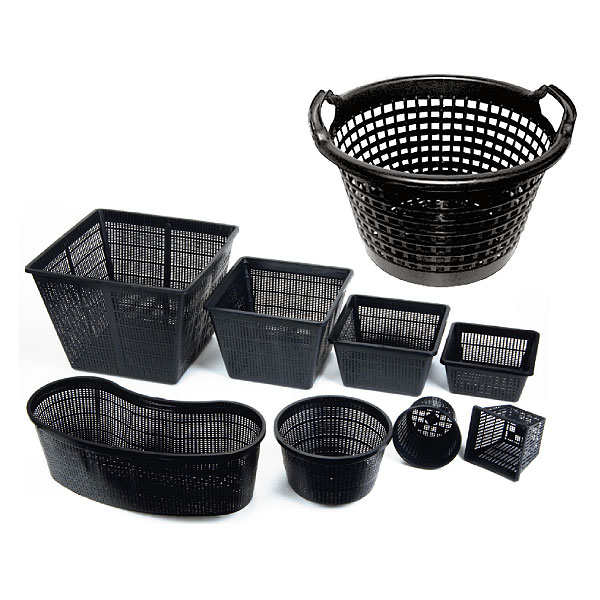
The container for water lilies can be chosen in any shape
Nymphea can be planted directly in the reservoir soil, but this will complicate the care of it and create problems with wintering, unless of course it is a frost-resistant variety of snow-white water lily.
The option is real, so it is also worth considering. Here the main question will be about the organization of a sufficient layer of soil. The soil must securely hold the plant. The thickness of the bottom soil is directly proportional to the water lily variety. Small specimens can also be kept by a bedding of 10 cm, but for growing large varieties of water lilies, two or even three times more land will be required. Wild species of water lilies transferred to sandy soil will need top dressing from fresh manure. You can use another type of organic fertilizer when caring for a water lily.
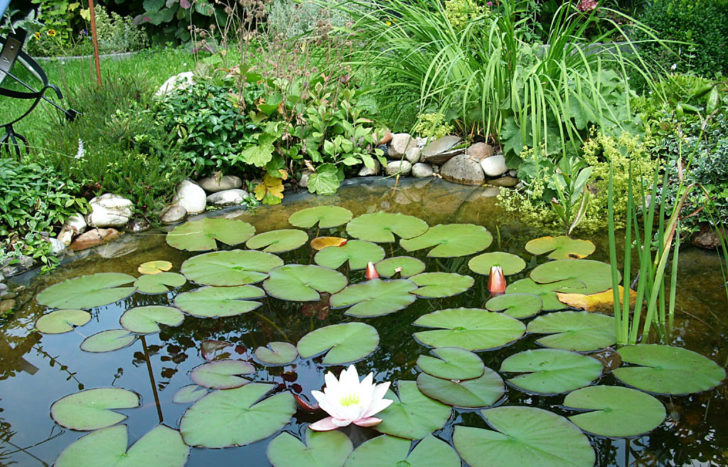
The soil must securely hold the water lily
Disembarkation time
For cultivated varieties, including snow-white water lilies, planting time is limited to May-June. Landing rules provide for a gradual topping up of water in reservoirs. This applies to pools and other facilities where the regulation of filling is possible. In the first few days, the level of standing water is increased by several centimeters. In a week, the volume of water can already be brought to the desired indicators.

Rules for planting water lilies
Care
The decorativeness of water lilies for a pond may fade if they are not properly cared for. The problem of plants in the rapid growth. Having covered the entire water surface with themselves, they will begin to destroy themselves. Individuals become smaller, flowering practically stops, and a chaotic pile of young and old leaves creates an unpleasant sight.
Having decided to start breeding water lilies, do not plant more than half of the reservoir with plants. Each densely growing group of water lilies should consist of solid varieties. If there is a desire to see a kind of color mix in the pond, then divide the multi-colored landings into zones and leave a section of a personal water area near each.

Water lilies should not occupy more than half of the reservoir
Otherwise, caring for water lilies for a pond is an unobtrusive procedure. Containers with water lilies are removed from their usual habitat no more than once every three years, unless this procedure, of course, is required by the organization of wintering.This is usually done in the middle of May, while the plants have not yet begun to bloom.
The removed containers are inspected for integrity, cleaned of organic debris. Do the same with the reservoir. Fallen leaves and other foreign inclusions must be removed from it.
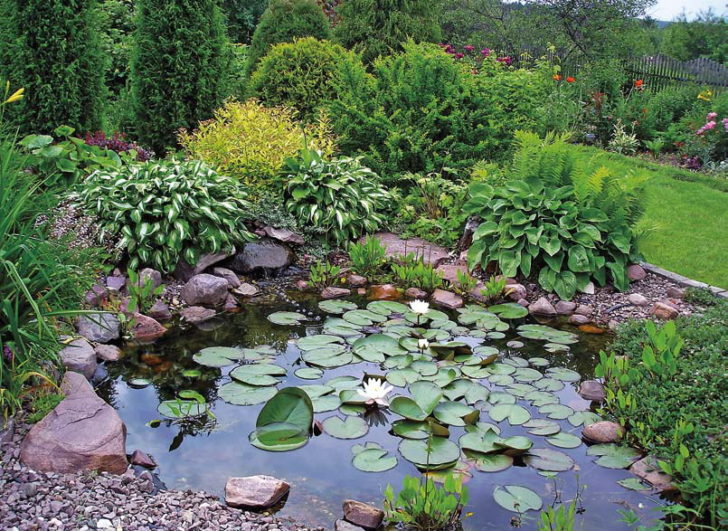
Regularly clean the pond of fallen leaves
During the season, nymphea care comes down to removing yellowing foliage and faded buds.
Can the pitcher be rearranged?
If there is a need to move them during the cultivation of water lilies, then this should be done before the growing season begins. The presence of buds is a complete contraindication to plant anxiety.
If absolutely necessary, move the flowering water lily to a given area, but at the same time leave it to bask in shallow water, where the water layer is noticeably warmer. In places with great depth, a brick stand is used for this. As the stem and leaves develop, move your water lily deeper or gradually reduce the layers of bricks underneath.
reproduction
Water lilies for the pond are bred by dividing the rhizome. Plants of wild species, such as the snow-white water lily, are lifted out of the water in April-May and, using a sharp knife, they cut off the shoots that have branched off from the main root trunk. The cut must be disinfected by sprinkling with crushed charcoal. The latter can be replaced with ash. Each such element must have dormant buds. Billets of future water lilies are placed in properly prepared landing containers. The latter are sent to larger containers, which are filled with water so that it covers the container with seedlings by 2 cm. The water lilies ready for cultivation are taken out into the sun and left to take root under its rays.

Water lilies are bred by dividing the rhizome
Reproduction of tropical species of nymphs falls on the month of April. The essence of the procedure is similar to that described above, but you will have to take care of the care. After planting the material, the containers are kept in water with a constant temperature not exceeding +200 and not falling below +180. The signal to move to a permanent place of growth will be the appearance of the first leaves in water lilies for the pond.

The division of the water lily bush
Some types of water lilies are more specific in their reproduction. Their cubs bud off in the thick of leaves. They are carefully isolated and transferred to separate containers, in the rest of the care, following the traditional prescriptions.
flowering period
With proper planting and care, the water lily blooms quickly enough. Even a tiny delenka, which only fell into the pond in May, will have a bud by July. Active flowering will continue until September.
Are there only water lilies in the pond?
Planting a pond exclusively with a snow-white water lily or other types of water lilies for a pond will not be entirely correct. Plants-oxygenators should certainly be settled in them. The task of the neighbors is to prevent the pond from overgrowing with unaesthetic algae and mud. If the reservoir is inhabited by fish, then for it such landings will become additional food.
What to choose?
1. Water star.
2. Swamp turkey.
3. Urut spiky.
4. Hornwort is dark green.
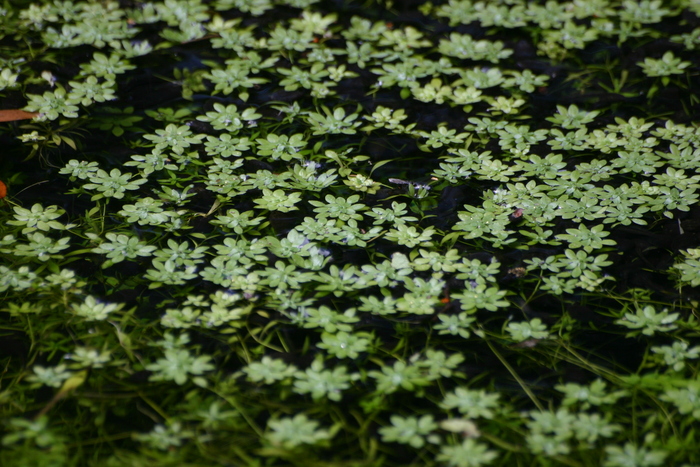
A water star is perfect for a neighborhood with a water lily
It will be right to purchase several varieties of oxygenators for your pond at once. You don't have to spend money on it. Shoots of turcha and uruti, for example, can be caught in a local lake, if there is one near your site.
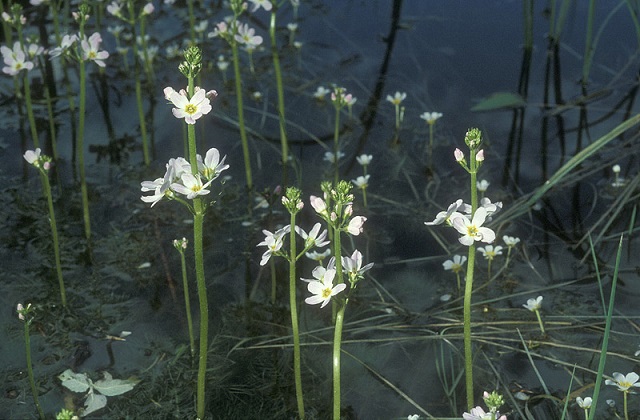
Turmeric marsh can be caught in the local lake
Wintering
This is the most difficult stage in caring for a water lily. How to prevent the nymphs from dying in the cold is decided individually. For example, frost-resistant varieties, such as snow-white water lilies, may not be removed from the pond if they are planted at a depth of at least half a meter, and the water column does not freeze to the bottom in winter.If the reservoir is drained for the winter or it is too shallow so as not to freeze, then the water lilies are sent for wintering to a cool, but not frosty place.
There are different wintering methods for water lilies. Containers with plants in the fall can be brought into the basement, where they are placed in prepared containers with water. Water lilies are examined, freed from old foliage and left in this state until spring.
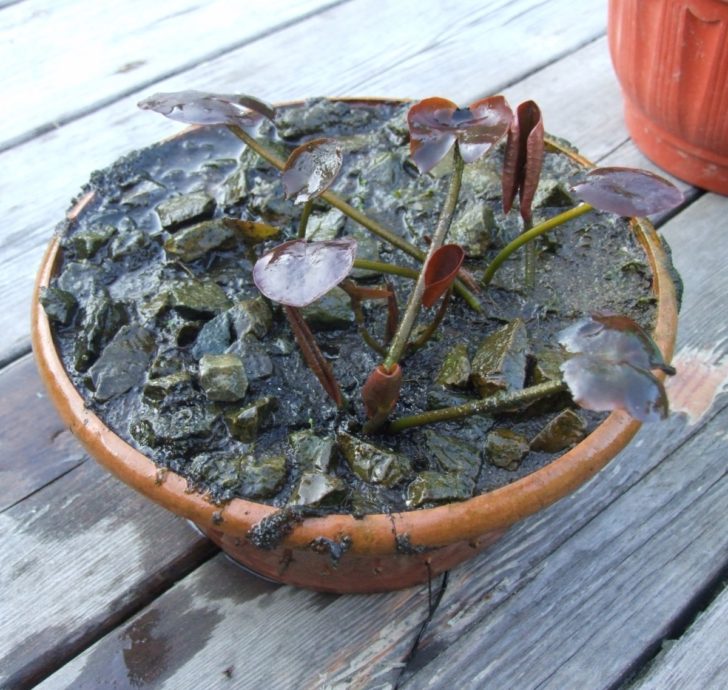
For wintering, water lilies in a container are placed in a cool place.
If the water lily was planted in an open way, then the plant is dug up and the roots with an earthen clod are transferred to a plastic bag. Tie the bags loosely so that air can circulate inside. Periodically, you need to check the condition of the soil and, if necessary, moisten it. The soil in the bags should not dry out.
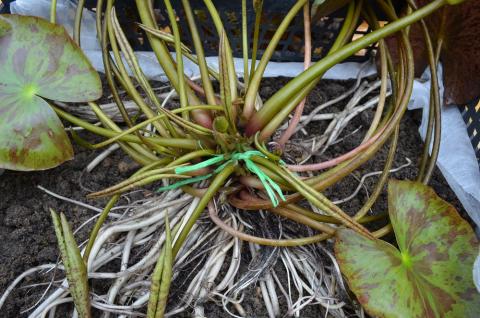
The soil in the container must not dry out.
In the case when the wintering of a water lily is organized in a pond, without digging up and transferring plants, it will be necessary to throw additional layers of snow on the frozen surface of the reservoir every time you visit the dacha. The result should be a hill at least one and a half meters high. Such a move will not allow the pond to freeze to the ground and the water lilies will feel much more comfortable.
Why isn't the water lily blooming?
Usually the cessation of flowering is associated with improper care.
When growing a water lily, they prefer calm, standing water. She can put up with a slow current, but the fountain spray and the seething swirls of waterfalls are fatal for her. If the water lily does not wither completely, then it will not throw out the buds for sure.
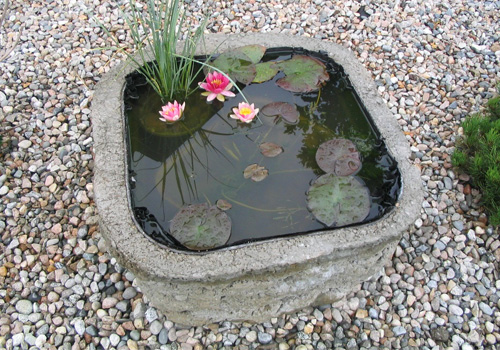
Water lilies prefer standing water.
The snow-white water lily, however, like other representatives of the nymphs, does not tolerate crowding. Each plant needs personal space, approximately equal to a square meter. Planting water lilies is characterized by rapid growth, which will entail such a care procedure as seating.
A sure sign that the time has come to do this is the leaves curling up into a tube. If thinning is not done in the shortest possible time, water lilies are crushed and will bloom worse. Transplantation can be combined with reproduction. Separated daughter plants are placed in new containers or distributed to neighbors.
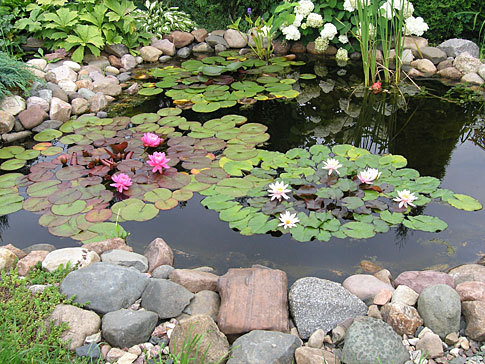
The water lily does not tolerate crowding
The water lily is light-loving. She must see the sun for at least 5 hours. In dense shade, the nymphaeum is ready to throw out only leaves. It is not realistic to wait for flowering from her.
The reason for weak flowering can also be the depletion of the soil. Here the problem can be solved by fertilizing and changing the land.
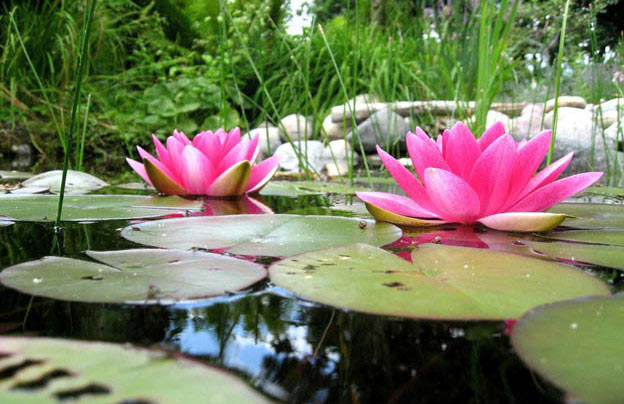
Choose a sunny location to plant water lilies
The quality and activity of flowering will be affected by the wintering conditions of the water lily. If the plant is frozen (this also applies to snow-white water lilies, which are frost-resistant), then it will leave for a long time, and flowers will appear only by the end of summer.
back to index ↑Water lily diseases
The following diseases are most dangerous for nymphs:
1. Leaf spot.
2. Black rot.
Warm and at the same time too humid weather near pond water lilies call for fungal infections. The first signs of a fungal attack are reddish or brownish spots on still green leaves. The lesions grow rapidly and spread to other parts of the plant. Treatment consists in the treatment of water lilies with special compounds. Leaves with severe damage should be cut and destroyed. Powdery mildew is dealt with in the same way.
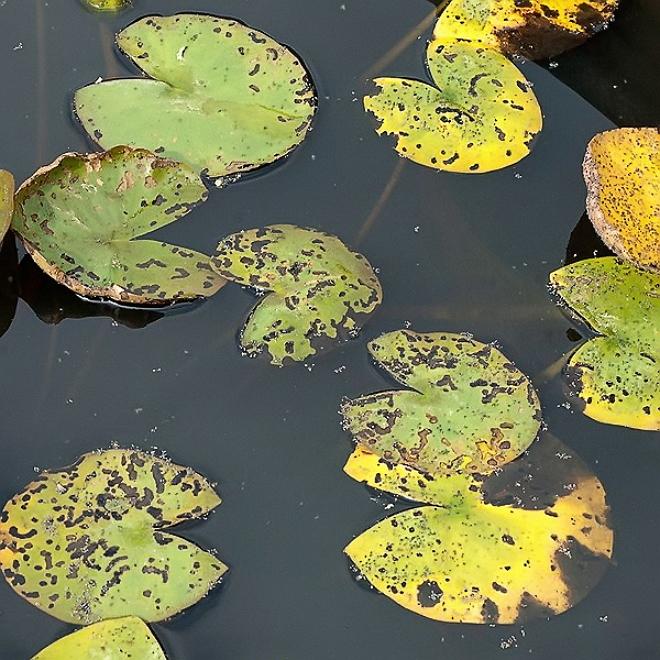
Water lily leaf damage
Black rot is a root disease. The problem is not immediately recognizable. Usually, when growing water lilies, they begin to think about damage to the roots, noticing the yellowing of the leaves and smelling an unpleasant smell from the water. Water lilies with black rot require specific treatment and care. They will have to be dug out of the pond and transferred to a bathroom with an antifungal solution. After the treatment session, the lilies are sent to a monthly quarantine.If there is no relapse, the nymphs are returned to the pond. Otherwise, the plant, even if it is a unique snow-white water lily, is destroyed. It is not worth talking about the danger of water lilies affected by black rot for the pond. Having regretted one individual, you can lose the entire water front garden.

Water lily root affected by root rot.
Enemies of water lilies
“The most terrible is the swamp moth, which literally in an hour can destroy an entire plantation of a snow-white water lily, which has rather large leaves, while dwarf varieties disappear just before our eyes”
In addition to diseases, water lilies suffer from aphids, swamp moths and leaf beetles. The former are fought off by spraying the leaves with an infusion of horsetail or breeding a population of ladybugs.
The presence of a leaf beetle will be signaled by oblong holes on the smooth leaves of water lilies. Adult goats are harvested by hand. When larvae are found, the water lily is immersed under water for at least 5 days.
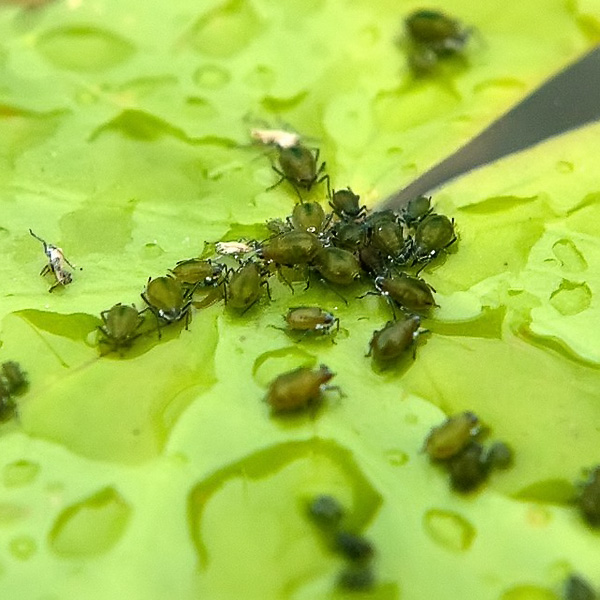
Leaf beetle on a water lily
The most terrible is the swamp moth, which literally in an hour can destroy an entire plantation of a snow-white water lily, which has rather large leaves, while dwarf varieties disappear just before our eyes. Insects and their offspring are harvested by hand.
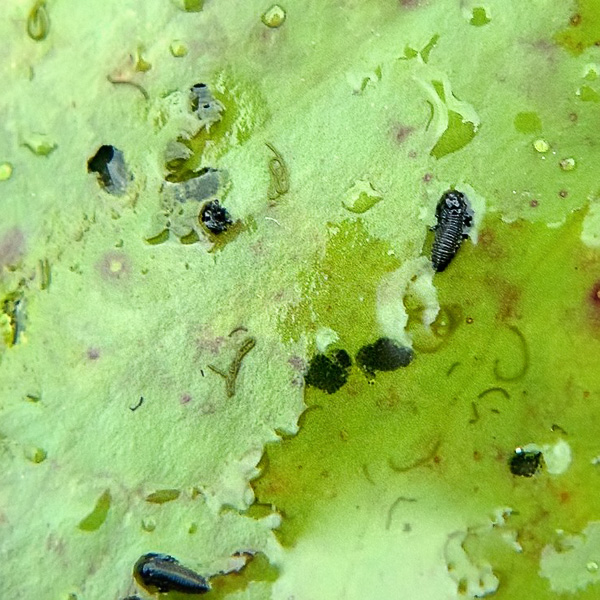
marsh moth
Conclusion
The charm of the water lily is unique. The plant itself is not particularly whimsical. Growing a water lily and caring for it is not a hassle. Isn't this a reason to put her in your country pond and enjoy the aesthetic view?
Photo gallery - water lilies
Video
